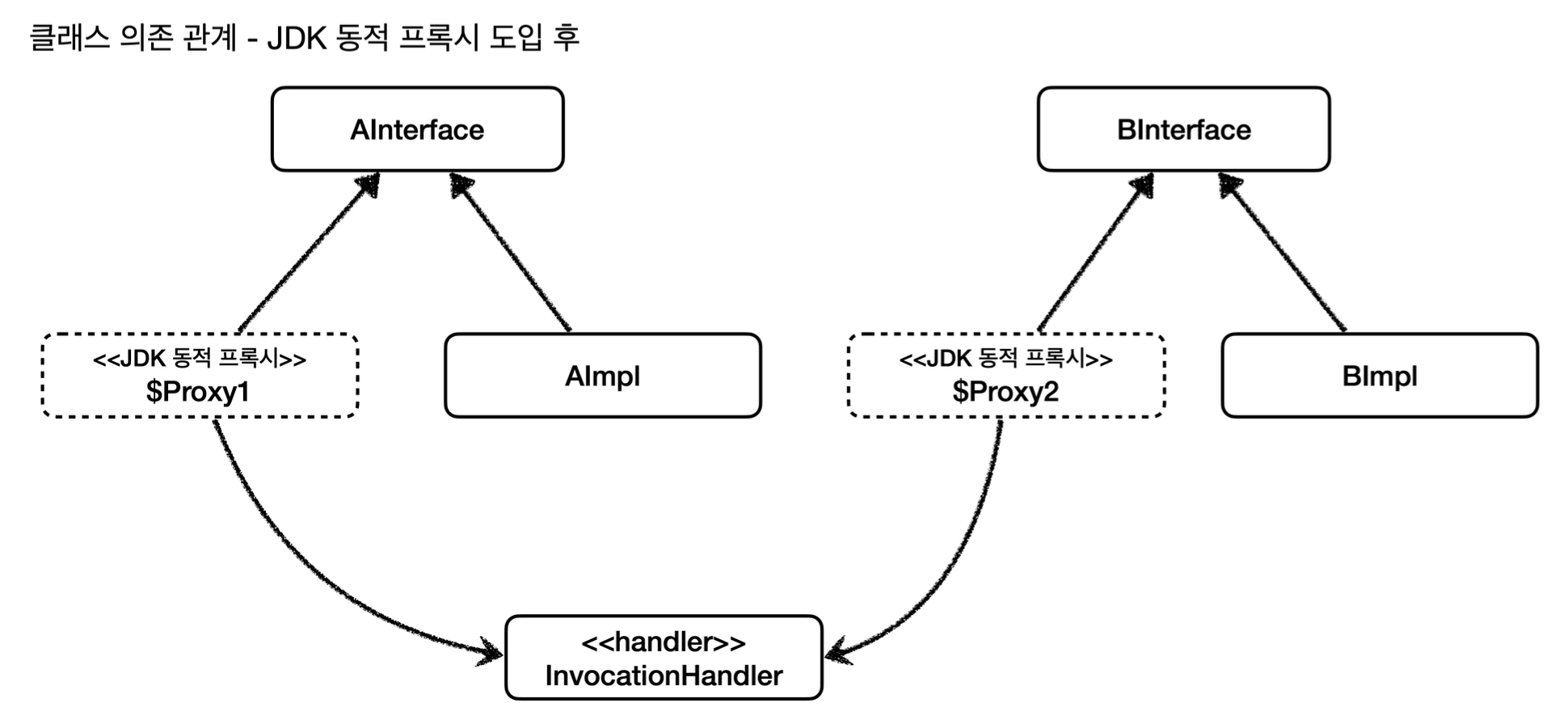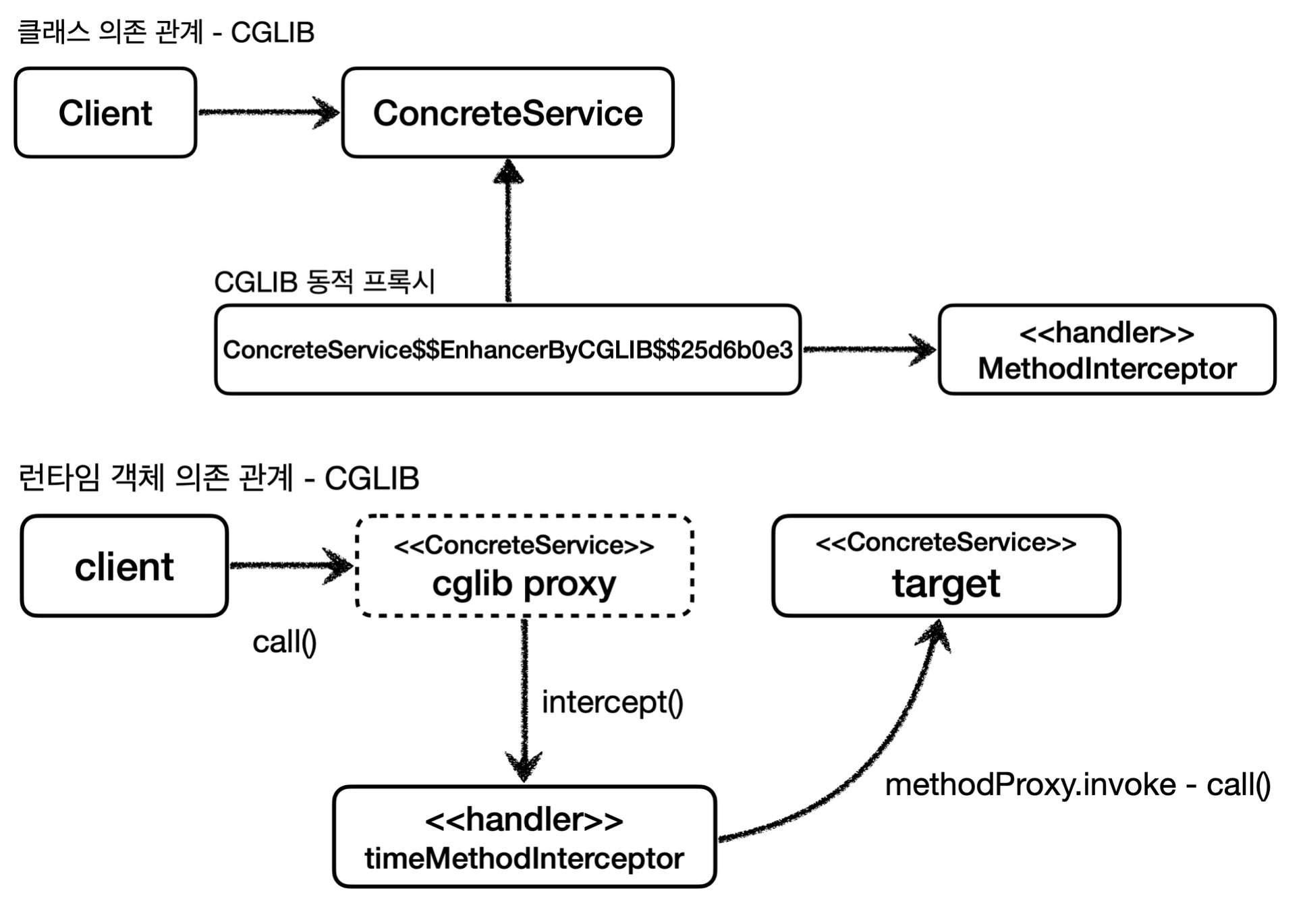![[Spring 핵심원리 - 고급] 동적 프록시(Dynamic Proxy)](https://img1.daumcdn.net/thumb/R750x0/?scode=mtistory2&fname=https%3A%2F%2Fblog.kakaocdn.net%2Fdna%2FbBncop%2FbtsNlmaLBC8%2FAAAAAAAAAAAAAAAAAAAAAL4NvPbxueZ9khaIly5FLSY-GbN_tOvJLTszTm_3xiii%2Fimg.png%3Fcredential%3DyqXZFxpELC7KVnFOS48ylbz2pIh7yKj8%26expires%3D1764514799%26allow_ip%3D%26allow_referer%3D%26signature%3DUV1OIWQhZPojN1ir0cVuQdZ2dSo%253D)

이 글은 인프런 김영한님의 Spring 강의를 바탕으로 개인적인 정리를 위해 작성한 글입니다.
리플렉션
- JDK 동적 프록시를 이해하기 위해서는 먼저 자바의 리플렉션 기술을 이해해야 한다.
- 리플렉션 기술을 사용하면 클래스나 메서드의 메타정보를 동적으로 획득하고, 코드도 동적으로 호출할 수 있다.
import lombok.extern.slf4j.Slf4j;
import org.junit.jupiter.api.Test;
import java.lang.reflect.Method;
@Slf4j
public class ReflectionTest {
@Slf4j
static class Hello {
public String callA() {
log.info("callA");
return "A";
}
public String callB() {
log.info("callB");
return "B";
}
}
@Test
void reflection1() throws Exception {
//클래스 정보
Class classHello = Class.forName("proxy.proxy.jdkdynamic.ReflectionTest$Hello");
Hello target = new Hello();
//callA 메서드 정보
Method methodCallA = classHello.getMethod("callA");
Object result1 = methodCallA.invoke(target);
log.info("result1={}", result1);
//callB 메서드 정보
Method methodCallB = classHello.getMethod("callB");
Object result2 = methodCallB.invoke(target);
log.info("result2={}", result2);
}
}- Class.forName("hello.proxy.jdkdynamic.ReflectionTest$Hello") : 클래스 메타정보를 획득한다. 참고로 내부 클래스는 구분을 위해 $ 를 사용한다.
- classHello.getMethod("call") : 해당 클래스의 call 메서드 메타정보를 획득한다.
- methodCallA.invoke(target) : 획득한 메서드 메타정보로 실제 인스턴스의 메서드를 호출한다.
여기서 methodCallA 는 Hello 클래스의 callA() 이라는 메서드 메타정보이다.
methodCallA.invoke(인스턴스) 를 호출하면서 인스턴스를 넘겨주면 해당 인스턴스의 callA() 메서드를 찾아서 실행한다.
여기서는 target 의 callA() 메서드를 호출한다.

@Test
void reflection2() throws Exception {
//클래스 정보
Class classHello = Class.forName("proxy.proxy.jdkdynamic.ReflectionTest$Hello");
Hello target = new Hello();
Method methodCallA = classHello.getMethod("callA");
dynamicCall(methodCallA, target);
Method methodCallB = classHello.getMethod("callB");
dynamicCall(methodCallB, target);
}
private void dynamicCall(Method method, Object target) throws Exception {
log.info("start");
Object result = method.invoke(target);
log.info("result={}", result);
}- dynamicCall(Method method, Object target) : 공통 로직을 한번에 처리할 수 있는 통합된 공통 처리 로직이다.
- Method method : 첫 번째 파라미터는 호출할 메서드 정보가 넘어온다. 이것이 핵심이다. 기존에는 메서드 이름을 직접 호출했지만, 이제는 Method 라는 메타정보를 통해서 호출할 메서드 정보가 동적으로 제공된다.
- Object target : 실제 실행할 인스턴스 정보가 넘어온다. 타입이 Object 라는 것은 어떠한 인스턴스도 받을 수 있다는 뜻이다. 물론 method.invoke(target) 를 사용할 때 호출할 클래스와 메서드 정보가 서로 다르면 예외가 발생한다.
정적인 target.callA(), target.callB() 코드를 리플렉션을 사용해서 `Method` 라는 메타정보로 추상화했다.
덕분에 공통 로직을 만들 수 있게 되었다.
리플렉션은 주의해서 사용해야한다.
리플렉션을 사용하면 클래스와 메서드의 메타정보를 사용해서 애플리케이션을 동적으로 유연하게 만들 수 있다. 하지만 리플렉션 기술은 런타임에 동작하기 때문에, 컴파일 시점에 오류를 잡을 수 없다.
따라서 리플렉션은 일반적으로 사용하면 안된다.
지금까지 프로그래밍 언어가 발달하면서 타입 정보를 기반으로 컴파일 시점에 오류를 잡아준 덕분에 개발자가 편하게 살았는데, 리플렉션은 그것에 역행하는 방식이다.
리플렉션은 프레임워크 개발이나 또는 매우 일반적인 공통 처리가 필요할 때 부분적으로 주의해서 사용해야 한다.
JDK 동적 프록시
JDK 동적 프록시에 적용할 로직은 InvocationHandler 인터페이스를 구현해서 작성하면 된다.
JDK 동적 프록시는 인터페이스를 기반으로 프록시를 동적으로 만들어준다. 따라서 인터페이스가 필수이다.
JDK 동적 프록시가 제공하는 InvocationHandler
public interface InvocationHandler {
public Object invoke(Object proxy, Method method, Object[] args)throws Throwable;
}제공되는 파라미터는 다음과 같다.
- Object proxy : 프록시 자신
- Method method : 호출한 메서드
- Object[] args : 메서드를 호출할 때 전달한 인수
public interface AInterface {
String call();
}
@Slf4j
public class AImpl implements AInterface {
@Override
public String call() {
log.info("A 호출");
return "a";
}
}
public interface BInterface {
String call();
}
@Slf4j
public class BImpl implements BInterface {
@Override
public String call() {
log.info("B 호출");
return "b";
}
}
import lombok.extern.slf4j.Slf4j;
import java.lang.reflect.InvocationHandler;
import java.lang.reflect.Method;
@Slf4j
public class TimeInvocationHandler implements InvocationHandler {
private final Object target;
public TimeInvocationHandler(Object target) {
this.target = target;
}
@Override
public Object invoke(Object proxy, Method method, Object[] args) throws Throwable {
log.info("TimeProxy 실행");
long startTime = System.currentTimeMillis();
Object result = method.invoke(target, args);
long endTime = System.currentTimeMillis();
long resultTime = endTime - startTime;
log.info("TimeProxy 종료 resultTime={}", resultTime);
return result;
}
}- Object target : 동적 프록시가 호출할 대상
- method.invoke(target, args) : 리플렉션을 사용해서 target 인스턴스의 메서드를 실행한다. args 는 메서드 호출시 넘겨줄 인수이다.
import proxy.proxy.jdkdynamic.code.*;
import lombok.extern.slf4j.Slf4j;
import org.junit.jupiter.api.Test;
import java.lang.reflect.Proxy;
@Slf4j
public class JdkDynamicProxyTest {
@Test
void dynamicA() {
AInterface target = new AImpl();
TimeInvocationHandler handler = new TimeInvocationHandler(target);
AInterface proxy = (AInterface) Proxy.newProxyInstance(AInterface.class.getClassLoader(), new Class[]{AInterface.class}, handler);
proxy.call();
log.info("targetClass={}", target.getClass());
log.info("proxyClass={}", proxy.getClass());
}
@Test
void dynamicB() {
BInterface target = new BImpl();
TimeInvocationHandler handler = new TimeInvocationHandler(target);
BInterface proxy = (BInterface) Proxy.newProxyInstance(BInterface.class.getClassLoader(), new Class[]{BInterface.class}, handler);
proxy.call();
log.info("targetClass={}", target.getClass());
log.info("proxyClass={}", proxy.getClass());
}
}new TimeInvocationHandler(target)
- 동적 프록시에 적용할 핸들러 로직이다.
Proxy.newProxyInstance(AInterface.class.getClassLoader(), new Class[] {AInterface.class}, handler)
- 동적 프록시는 java.lang.reflect.Proxy 를 통해서 생성할 수 있다.
- 클래스 로더 정보, 인터페이스, 그리고 핸들러 로직을 넣어주면 된다. 그러면 해당 인터페이스를 기반으로 동적 프록시를 생성하고 그 결과를 반환한다.
dynamicA() 출력 결과

dynamicB() 출력 결과

실행 순서
- 클라이언트는 JDK 동적 프록시의 call()을 실행한다.
- JDK 동적 프록시는 InvocationHandler.invoke()를 호출한다.
TimeInvocationHandler가 구현체로 있으므로 TimeInvocationHandler.invoke()가 호출된다. - TimeInvocationHandler가 내부 로직을 수행하고, method.invoke(target, args)를 호출해서 target인 실제 객체(AImpl)를 호출한다.
- AImpl 인스턴스의 call()이 실행된다.
- AImpl 인스턴스의 call()의 실행이 끝나면 TimeInvocationHandler로 응답이 돌아온다. 시간 로그를 출력하고 결과를 반환한다.

JDK 동적 프록시 기술 덕분에 적용 대상 만큼 프록시 객체를 만들지 않아도 된다.
그리고 같은 부가 기능 로직을 한번만 개발해서 공통으로 적용할 수 있다. 만약 적용 대상이 100개여도 동적 프록시를 통해서 생성하고, 각각 필요한 InvocationHandler 만 만들어서 넣어주면 된다.
결과적으로 프록시 클래스를 수 없이 만들어야 하는 문제도 해결하고, 부가 기능 로직도 하나의 클래스에 모아서 단일 책임 원칙(SRP)도 지킬 수 있게 되었다.

CGLIB
JDK 동적 프록시와 CGLIB와의 가장 큰 차이는 인터페이스의 존재 여부이다.
- JDK 동적 프록시: 인터페이스가 필수
- CGLIB: 인터페이스 없어도 됨(구현 클래스만 있어도 OK)
CGLIB는 구현 클래스를 상속해서 하위 클래스로 프록시를 생성한다.
JDK 동적 프록시에서 실행 로직을 위해 InvocationHandler 를 제공했듯이, CGLIB는 MethodInterceptor를 제공한다.
MethodInterceptor
package org.springframework.cglib.proxy;
public interface MethodInterceptor extends Callback {
Object intercept(Object obj, Method method, Object[] args, MethodProxy proxy) throws Throwable;
}- obj : CGLIB가 적용된 객체
- method : 호출된 메서드
- args : 메서드를 호출하면서 전달된 인수
- proxy : 메서드 호출에 사용
import lombok.extern.slf4j.Slf4j;
import org.springframework.cglib.proxy.MethodInterceptor;
import org.springframework.cglib.proxy.MethodProxy;
import java.lang.reflect.Method;
@Slf4j
public class TimeMethodInterceptor implements MethodInterceptor {
private final Object target;
public TimeMethodInterceptor(Object target) {
this.target = target;
}
@Override
public Object intercept(Object obj, Method method, Object[] args, MethodProxy methodProxy) throws Throwable {
log.info("TimeProxy 실행");
long startTime = System.currentTimeMillis();
Object result = methodProxy.invoke(target, args);
long endTime = System.currentTimeMillis();
long resultTime = endTime - startTime;
log.info("TimeProxy 종료 resultTime={}", resultTime);
return result;
}
}- TimeMethodInterceptor 는 MethodInterceptor 인터페이스를 구현해서 CGLIB 프록시의 실행 로직을 정의한다.
- JDK 동적 프록시를 설명할 때 예제와 거의 같은 코드이다.
- Object target : 프록시가 호출할 실제 대상
- proxy.invoke(target, args) : 실제 대상을 동적으로 호출한다
method 를 사용해도 되지만, CGLIB는 성능상 MethodProxy proxy 를 사용하는 것을 권장한다.
@Slf4j
public class ConcreteService {
public void call() {
log.info("ConcreteService 호출");
}
}
import proxy.proxy.cglib.code.TimeMethodInterceptor;
import proxy.proxy.common.service.ConcreteService;
import lombok.extern.slf4j.Slf4j;
import org.junit.jupiter.api.Test;
import org.springframework.cglib.proxy.Enhancer;
@Slf4j
public class CglibTest {
@Test
void cglib() {
ConcreteService target = new ConcreteService();
Enhancer enhancer = new Enhancer();
enhancer.setSuperclass(ConcreteService.class);
enhancer.setCallback(new TimeMethodInterceptor(target));
ConcreteService proxy = (ConcreteService) enhancer.create();
log.info("targetClass={}", target.getClass());
log.info("proxyClass={}", proxy.getClass());
proxy.call();
}
}ConcreteService는 인터페이스가 없는 구체 클래스이다.
- Enhancer: CGLIB는 Enhancer를 사용해서 프록시를 생성한다.
- enhancer.setSuperclass(ConcreteService.class): CGLIB는 구체 클래스를 상속 받아서 프록시를 생성할 수 있다. 어떤 구체 클래스를 상속 받을지 지정한다.
- enhancer.setCallback(new TimeMethodInterceptor(target)): 프록시에 적용할 실행 로직을 할당한다.
- enhancer.create(): 프록시를 생성한다. 앞서 설정한 enhancer.setSuperclass(ConcreteService.class)에서 지정한 클래스를 상속 받아서 프록시가 만들어진다.
JDK 동적 프록시는 인터페이스를 구현(implement)해서 프록시를 만든다. CGLIB는 구체 클래스를 상속(extends)해서 프록시를 만든다.

CGLIB 단점
클래스 기반 프록시는 상속을 사용하기 때문에 몇가지 제약이 있다.
- 부모 클래스의 생성자를 체크해야 한다. -> CGLIB는 자식 클래스를 동적으로 생성하기 때문에 기본 생성자가 필요하다.
- 클래스에 final 키워드가 붙으면 상속이 불가능하다. -> CGLIB에서는 예외가 발생한다.
- 메서드에 final 키워드가 붙으면 해당 메서드를 오버라이딩 할 수 없다. -> CGLIB에서는 프록시 로직이 동작하지 않는다.
'Back-End > Spring' 카테고리의 다른 글
| [Spring 핵심원리 - 고급] 빈 후처리기(BeanPostProcessor) (0) | 2025.04.16 |
|---|---|
| [Spring 핵심원리 - 고급] 프록시 팩토리(Proxy Factory) (0) | 2025.04.15 |
| [Spring 핵심원리 - 고급] 프록시 및 데코레이터 패턴(디자인 패턴) (0) | 2025.04.11 |
| [Spring 핵심원리 - 고급] 전략 패턴(디자인 패턴) (1) | 2025.04.10 |
| [Spring 핵심원리 - 고급] 템플릿 메서드 패턴(디자인 패턴) (0) | 2025.04.10 |
![[Spring 핵심원리 - 고급] 빈 후처리기(BeanPostProcessor)](https://img1.daumcdn.net/thumb/R750x0/?scode=mtistory2&fname=https%3A%2F%2Fblog.kakaocdn.net%2Fdna%2FxxVvq%2FbtsNmD5ksA2%2FAAAAAAAAAAAAAAAAAAAAANMPy1EQ8Y61UcZyd-xAdChzqbTr2OT0-aYdo0f1Q2B_%2Fimg.png%3Fcredential%3DyqXZFxpELC7KVnFOS48ylbz2pIh7yKj8%26expires%3D1764514799%26allow_ip%3D%26allow_referer%3D%26signature%3D9%252FnJs1XXmon1vTlOy1fS62UkTeE%253D)
![[Spring 핵심원리 - 고급] 프록시 팩토리(Proxy Factory)](https://img1.daumcdn.net/thumb/R750x0/?scode=mtistory2&fname=https%3A%2F%2Fblog.kakaocdn.net%2Fdna%2FJxRD5%2FbtsNlYOlrIh%2FAAAAAAAAAAAAAAAAAAAAANx0Bufi6nHXammd5rZ0MuLQTNGMx1BppYBoBCRrG_s-%2Fimg.png%3Fcredential%3DyqXZFxpELC7KVnFOS48ylbz2pIh7yKj8%26expires%3D1764514799%26allow_ip%3D%26allow_referer%3D%26signature%3D3vRcyNzmiiMeCfB%252BkQHPhLuPTpQ%253D)
![[Spring 핵심원리 - 고급] 프록시 및 데코레이터 패턴(디자인 패턴)](https://img1.daumcdn.net/thumb/R750x0/?scode=mtistory2&fname=https%3A%2F%2Fblog.kakaocdn.net%2Fdna%2FcRmpu7%2FbtsNi0kOFsx%2FAAAAAAAAAAAAAAAAAAAAACxEWES-phNCOfFhbvhO384GS9ky5WmCL9vVN-RjmlVk%2Fimg.png%3Fcredential%3DyqXZFxpELC7KVnFOS48ylbz2pIh7yKj8%26expires%3D1764514799%26allow_ip%3D%26allow_referer%3D%26signature%3DGe7yLeI3qUl1alZfTDuAbdbwpjo%253D)
![[Spring 핵심원리 - 고급] 전략 패턴(디자인 패턴)](https://img1.daumcdn.net/thumb/R750x0/?scode=mtistory2&fname=https%3A%2F%2Fblog.kakaocdn.net%2Fdna%2FERrD8%2FbtsNeQQ7IYW%2FAAAAAAAAAAAAAAAAAAAAAMo3msbSp0j4dA1X43tqeyUIKJgJvkCPsZ6y05Zm-leG%2Fimg.png%3Fcredential%3DyqXZFxpELC7KVnFOS48ylbz2pIh7yKj8%26expires%3D1764514799%26allow_ip%3D%26allow_referer%3D%26signature%3DmlJ5N%252F%252BaKuLEqggbl9QIC%252B2D0yw%253D)